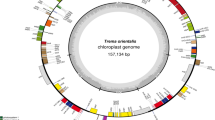Abstract.
Phylogenetic schemes based on changing DNA sequence have made a major impact on our understanding of evolutionary relationships and significantly built on knowledge gained by morphological and anatomical studies. Here we present another approach to phylogeny, using fluorescent in situ hybridisation. The phylogenetic scheme presented is likely to be robust since it is derived from the chromosomal distribution of ten repetitive sequences with different functions and evolutionary constraints [GRS, HRS60, NTRS, the Arabidopsis-type telomere repeat (TTTAGGG)n, 18S-5.8S-26S ribosomal DNA (rDNA), 5S rDNA, and four classes of geminiviral-related DNA (GRD)]. The basic karyotypes of all the plant species investigated Nicotiana tomentosiformis, N. kawakamii, N. tomentosa, N. otophora, N. setchellii, N. glutinosa (all section Tomentosae), and N. tabacum (tobacco, section Genuinae) are similar (x=12) but the distribution of genic and non-genic repeats is quite variable, making the karyotypes distinct. We found sequence dispersal, and locus gain, amplification and loss, all within the regular framework of the basic genomic structure. We predict that the GRD classes of sequence integrated into an ancestral genome only once in the evolution of section Tomentosae and thereafter spread by vertical transmission and speciation into four species. Since GRD is similar to a transgenic construct that was inserted into the N. tabacum genome, its fate over evolutionary time is interesting in the context of the debate on genetically modified organisms and the escape of genes into the wild. Nicotiana tabacum is thought to be an allotetraploid between presumed progenitors of N. sylvestris (maternal, S-genome donor) and a member of section Tomentosae (T-genome donor). Of section Tomentosae, N. tomentosiformis has the most similar genome to the T genome of tobacco and is therefore the most likely paternal genome donor. It is known for N. tabacum that gene conversion has converted most 18S-5.8S-26S rDNA units of N. sylvestris origin into units of an N. tomentosiformis type. Clearly if such a phenomenon were widespread across the genome, genomic in situ hybridisation (GISH) to distinguish the S and T genomes would probably not work since conversion would tend to homogenise the genomes. The fact that GISH does work suggests a limited role for gene conversion in the evolution of N. tabacum.
Similar content being viewed by others
Author information
Authors and Affiliations
Additional information
Received: 8 November 1999; in revised form: 23 February 2000 / Accepted: 1 March 2000
Rights and permissions
About this article
Cite this article
Lim, K., Matyášek, R., Lichtenstein, C. et al. Molecular cytogenetic analyses and phylogenetic studies in the Nicotiana section Tomentosae. Chromosoma 109, 245–258 (2000). https://doi.org/10.1007/s004120000074
Issue Date:
DOI: https://doi.org/10.1007/s004120000074




